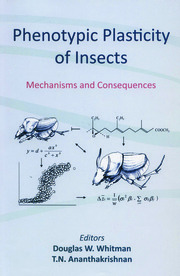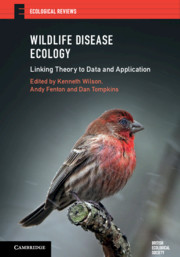Papers
Withers A.J., de Boer, J., Chipabika, G., Zhang, L., Smith, J.A., Jones, C.M. & Wilson K.
Bateman, ML, Day, RK, Rwomushana, I, Subramanian, S, Wilson, K, Babendreier, D, Luke, B & Edgington, S.
Xiao, Y., Li, W., Yang, X., Xu, P., Jin, Minghui, Yuan, H., Zheng, W., Soberon, M., Bravo, A., Wilson, K. & Wu, K
Wilson, K., Grzywacz, D., Cory, J.S., Donkersley, P. & Graham, R.I. (2021)
Ponton, F., Morimoto, J., Robinson, K., Kumar, S., Cotter, S.C., WILSON, K.; Simpson, S. (Jul 2020)
WILSON, K. Holdbrook, R., Reavey, CE. Randall, JL., Tummala, Y., Ponton, F., Simpson, SJ, Smith, JA & Cotter, SC (2020)
Xu, P., Yang, L., Tang, X., Li, T., Graham, RI., Wu, K. & WILSON, K. (2020)
WILSON, K., Grzywacz, D., Curcic, I., Scoates, F., Harper, K., Rice, A., Paul, N. & Dillon, A. (2020)
Zhang, L., Liu, B., Zheng, Z., Liu, C., Zhang, D., Zhao, S., Li, Z., Xu, P., WILSON, K., Withers, A., Jones, C.M., Smith, J.A., Chipabika, G., Kachigamba, D.L., Nam, K., d'Alençon, E., Liu, B., Liang, X., Jin, M., Wu, C., Chakrabarty, S., Yang, X., Jiang, Y., Liu, J., Liu, X., Quan, W., Wang, G., Fan, W., Qian, W., Wu, K., Xiao, Y. (2020)
Leivesley, J., Bussiere, L., Pemberton, J., Pilkington, J.G., Wilson, K. & Hayward, A. (2019)
Cotter, SC, Reavey, CE, Tummala, Y., Randall, JL, Holdbrook, R, Ponton, F, Simpson, SJ, Smith JA, & Wilson, K. (2019)
Wilson, K., Sheldon, B.C., Gaillard, J.M., Sanders, N.J., Hoggart, S.P.G. & Newton, E. (2019)
Yang, X.M., Xu, P.J., Yuan, H., Graham, R.I., Wilson, K. & Wu, K. (2019)
Wilson, K., Sheldon, B.C., Gaillard, J.M., Sanders, N.J., Hoggart, S.P.G. & Newton, E. (2018)
Minter, M., Pearson, A., Lim, K.S., WILSON, K., Chapman, J.W. & Jones, C.M. (2018)
Carlsson, A.M., Albon, S.D., Coulson, S.J., Ropstad, E., Stien, A., Wilson, K., Egil Loe, L., Veiberg, V. & Irvine, R.J. (2018)
Wilson, K., Sheldon, B.C., Gaillard, J.M., Sanders, N.J., Hoggart, S.P.G. & Newton, E. (2018)
Donkersley, P., Rhodes, G., Pickup, R., Jones, K. & Wilson, K. (2017)
Antwis, R.; Griffiths, S.; Harrison, X.; Aranega-Bou, P.; Arce, A.; Bettridge, A.; Brailsford, F.; de Menezes, A.; Devaynes, A.; F., K.; Fry, E.; Goodhead, I.; Haskell, E.; Heys, C.; James, C.; J., S.; L., Gillian; L., Z.; Macey, M.l; McCarthy, A.; McDonald, J.; Mejia Florez, N.; O'Brien, D.; Orland, C.; P., M.; Reid, W.; Robinson, H.; Wilson, K.; Sutherland, W. (2017)
Graham, A.L., Nussey, D.H., Lloyd-Smith, J.O., Longbottom, D., Maley, M., Pemberton, J.M., Pilkington, J.G., Prager, K.C., Smith, L., Watt, K.A., Wilson, K., McNeilly, T.N., & Brulisauer, F. (2016)
Wong, A,C-N, Holmes, A., Ponton, F., Lihoreau, M., Wilson, K. Raubenheimer, D. & Simpson, S.J. (2015)
Graham, R.I., Tummala, Y., Rhodes, G., Cory, J.S., Shirras, A., Grzywacz, D. & Wilson, K. (2015)
Reynolds, A.M., Jones, H.B.C., Hill, J.K., Pearson, A.J., Wilson, K., Wolf, S., Lim, K.S., Reynolds, D.R. & Chapman, J.W. (2015)
Benskin, C. McW., Rhodes, G., Pickup, R.W. Mainwaring, M.C., Wilson, K. & Hartley, I.R. (2015)
Ponton, F., Wilson, K., Holmes, A., Raubenheimer, D., Robinson, K.L. & Simpson, S.J. (2014)
Graham, R.I., Deacutis, J.M., Pulpitel, T., Ponton, F., Simpson, S.J., Wilson, K. (2014)
Grzywacz, D., Stevenson, P.C., Mushobozi, W.L., Belmain, S. & Wilson, K. (2014)
Books and Chapters
- Chapters
-
- Books
-


